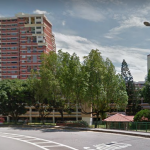The Housing & Development Board (HDB) has replied to letter writer Cheang Peng Wah that it “would be inaccurate to extrapolate the population size from the living density figure”. Cheang had, in writing to the Straits Times, expressed alarm at the population figures presented by HDB chief executive Dr Cheong Koon Hean. In her IPS-Nathan lecture, Dr Cheong said that Singapore’s density would increase from 11,000 people per sq km to 13,700 people per sq km between now and 2030.
The letter writer, Cheang Peng Wah, pointing to Singapore’s land area which is 720 sq km, expressed his unease that Singapore’s population size could go up to 9,864,000, or nearly 10 million, by 2030. He said that this was not the figure projected in the Population White Paper of 2013. The White Paper had projected a population of 6.9 million by 2030.
Cheang asked the authorities to explain this new figure on population density, and “assure Singaporeans that everything is being planned to prepare for such an eventuality.”
In replying to Cheang, HDB said that Dr Cheong’s “lecture was about how Singapore can anticipate its urban future and develop “liveable density””, and that the “figures cited were, hence, on living density, and not population density.”
HDB’s reply further clarified that “living density takes into account only the land available for urban areas, and excludes land used for ports, airports, defence and utilities, among others.”
Some commentators have pointed out that there is a scarcity of information on “living density” on the internet.
Table of Contents
But according to a report in the International Making Cities Livable Council, Singapore is one of the densest and one of the most livable cities in the world. The writer of the report, Suzanne H Crowhurst Lennard, in pointing to a diagram which appeared in an article “10 Principles for Liveable High-rise Cities. Lessons from Singapore”, said that in evaluating city livability, the article failed to distinguish between quality of life and standard of living.
Suzanne, who has a PhD in architecture, explains that the graph was created in 2008 for the Centre for Liveable Cities (CLC), an arm of the Singapore government.
“Their “Liveability” index is based on Mercer’s 2012 “Quality of Living Survey”, produced for the benefit of multinational firms. It compares standard of living metrics such as “internal stability, law enforcement effectiveness, education, crime levels and the quality of health care”. There is no doubt that standard of living for expats with multinational firms and most residents is extremely high in Singapore. Economic growth is the nation’s most important goal, and it has one of the highest per capita GDP in the world.
“Quality of life, on the other hand, has to do with experienced sense of well-being. According to Argyle, it is the “immaterial aspects of the living situation like health, social relations or the quality of the natural environment.” In Europe, quality of life would also include “the extent to which social cohesion is deepened, social exclusion is diminished, and social capital is grown.” While the European Commission has not abandoned the goal of increasing GDP, it also “wants an economy that is sustainable.””
She added that “density is a very slippery concept,” and that “when density is measured over a very large metropolitan area (as for the purposes of this graph) that varies in size from city to city, it does not provide very meaningful data.”
Suzanne said that the urban planners of Singapore have embraced a development trajectory which provides investors and developers with the biggest return on investment when the economy is strong. Such developments, though, are not the most ecologically sustainable form of construction.
https://www.icompareloan.com/resources/singapore-property-market-distorted/
Her report suggested that the Government of Singapore increased the living density in order to increase the country’s population as it would provide more options for economic growth.
‘It is also important to recognize the global political context of this report. Minister Mentor Lee Kuan Yew, Prime Minister for 30 years and widely recognized as the founding father of modern Singapore, is desperate to have Singapore proclaimed the most livable city in the world. Singaporeans are acutely aware of the economic advantages this would bring, and the country is so small that they do not have many options for economic growth other than to increase their population, and hence their density.”
A National University of Singapore (NUS) study, suggested that localised residential density may not only impact property prices in Singapore, but may also have unattended negative effects on welfare. The findings of the study said: “land use restrictions such as anti-sprawl measures that increase urban density as a by-product may have unattended negative effects on welfare.”
One of the key measures by which the Government of Singapore controls the overheated housing market is by limiting the supply of develop-able land. This is a type of anti-sprawl policy which would limit the supply of land for residential development, so that the price of housing (measured on a per-square-foot basis) would rise.
In response to this property price escalation, consumers would reduce their consumption of housing space, making new homes smaller than they would have been otherwise.
Dr Cheong had previously confirmed that the size of HDB flats has shrunk by 5 – 10 per cent over the last 20 to 30 years. A study by property consultancy Knight Frank in 2014 said that the sizes of condominium units here were also shrinking because developers have to keep new project prices affordable in ever tougher market conditions.
Some analysts have suggested that a larger population – and by extension more foreigners – would benefit Singapore in the long term. Professor Ng Yew Kwang of Nanyang Technological University for example, said in 2015 that there is a misconception that more people will make Singapore less of a livable city.
“A larger population will provide better business opportunities, a bigger market and more talent. It’s, in fact, good for Singaporeans,’ he added.
—
To read up more on property buying in Singapore to know what is noise and what is real. Or click here for the Ultimate Guide on Property Buying in Singapore.
Read about the En bloc sales process here:







